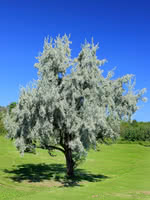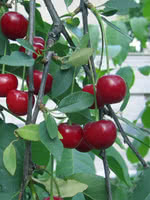Mon-Fri 9am - 5pm Mountain time
Russian Olive vs Sour Cherry
Elaeagnus angustifolia
Prunus cerasus
Russian Olive is a medium-sized deciduous tree that has attractive silvery coloured foliage with small yellow flowers that emit a fragrant sweet smell.
It is drought and salt tolerant, and works well as a shelterbelt species. Russian Olive can also be used to combat erosion.
Note: although Russian Olive is planted as an attractive boulevard tree in many northern areas, in warmer areas it can invade watersheds and is considered invasive. Please do some research and plant the right tree in the right place.
Sour Cherry is cold-hardy and typically grows as a small tree. In late spring, it produces clusters of fragrant white blossoms that mature into bright red, tart fruit. Although the cherries can be eaten fresh, they are most commonly used in baking and preserves.
While not native to North America, Sour Cherry serves as a larval host plant for the Eastern Tiger Swallowtail (Papilio glaucus), a butterfly native to eastern North America.
Sour cherries are self-fertile; however, planting near additional cherry trees for cross-pollination can increase yields.
This Sour Cherry is produced from seed collected from an Evans Cherry and is not clonally reproduced.
Russian Olive Quick Facts
Sour Cherry Quick Facts
In row spacing: 1.8 - 2.4 m (6 - 8 ft)

